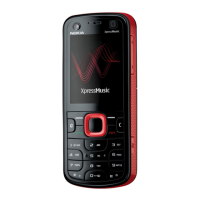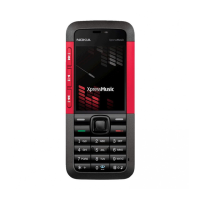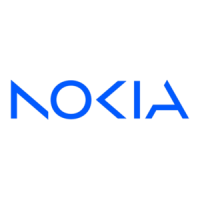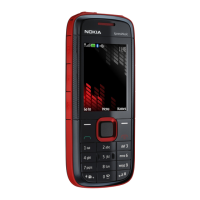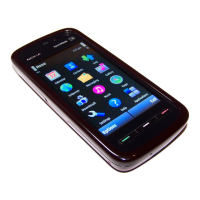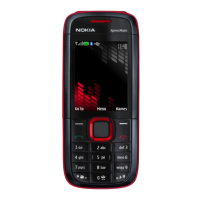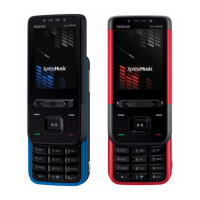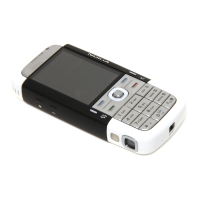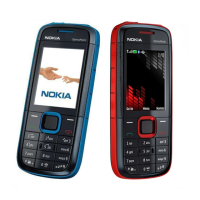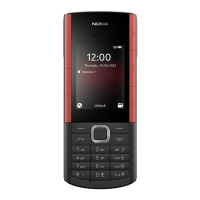Do you have a question about the Nokia XPRESSMUSIC 5320 and is the answer not in the manual?
Safety guidelines for powering on the device.
Adhering to traffic laws while using the device.
Instructions for switching off the device in specific zones.
Requirement for authorized personnel for repairs.
Accessing context-sensitive help and keyword lists.
Finding guides, downloads, and customer service online.
Obtaining new features and performance improvements via software updates.
Step-by-step guide to insert SIM card and battery.
Information on using compatible microSD and microSDHC memory cards.
Instructions on connecting the charger and charging the device.
Procedures for powering the device on and off.
Setting up the device for multimedia messaging, e-mail, and browser.
Steps to transfer information from an old device.
Identification of the device's physical keys and components.
Understanding the device's operational state when idle.
Explanation of the various icons and symbols on the display.
Navigating and accessing device functions through the menu system.
Methods for locking and unlocking the device keypad.
Managing security codes like PIN, PUK, and lock codes.
Remotely locking the device and memory card via text message.
Step-by-step instructions for initiating a voice call.
Accessing and managing voicemail services.
Using voice commands to initiate calls.
How to accept or decline incoming calls.
Procedures and requirements for making video calls.
Configuring various call-related options like caller ID and call waiting.
Setting up call forwarding to another number based on conditions.
Restricting outgoing and incoming calls with a password.
Sharing live video or clips during a voice call.
Viewing history of calls, messages, and data connections.
Playing music files and managing playback.
Navigating and playing music or podcast episodes.
Finding music using voice commands.
Creating and managing custom music playlists.
Accessing and listening to podcast episodes.
Browsing and purchasing music from the online store.
Searching, downloading, and managing podcasts.
Tuning into FM radio stations and managing settings.
Using different methods for text entry on the keypad.
Functions for selecting, copying, and deleting text.
Composing and sending text or multimedia messages.
Viewing and managing received messages.
Setting up and managing e-mail accounts and mailboxes.
Temporary storage for messages waiting to be sent.
Listening to received messages using text-to-speech.
Configuring text, multimedia, and e-mail message settings.
Adding, editing, and organizing contact details.
Creating groups for sending messages to multiple recipients.
Assigning custom ringtones to contacts and groups.
Organizing images, videos, and other media files.
Performing basic edits on images like cropping and rotating.
Creating and editing custom video clips.
Uploading media to online sharing services.
Using the main and secondary cameras to take photos.
Capturing video footage with the device's camera.
Adjusting resolution, flash, and other camera options.
Playing various media file formats and streaming content.
Recording voice calls and memos.
Accessing web pages and navigating the internet.
Managing saved web addresses and links.
Understanding and managing secure internet connections.
Downloading and using small web applications.
Using the search function for local services and online content.
Changing the device's visual appearance with themes.
Customizing tones and settings for different environments.
Setting the time, date, and world clock.
Setting and managing alarms with repeat options.
Managing appointments, tasks, and events.
Finding location, browsing maps, and planning routes.
Navigating and viewing map details.
Adjusting map display settings like zoom and view mode.
Downloading new map data for coverage.
Creating and managing text notes with multimedia.
Performing basic arithmetic calculations.
Converting measurements and currency exchange rates.
Translating words between different languages.
Viewing portable document format (.pdf) files.
Using applications for Word, Excel, and PowerPoint documents.
Using voice commands to control device functions.
Configuring general phone options like personalization and date/time.
Managing Bluetooth, USB, and data connection settings.
Adjusting language and voice settings for text reading.
Installing and uninstalling software packages on the device.
Browsing, managing, and organizing files and folders.
Erasing all data from a memory card.
Copying or synchronizing data between devices using Bluetooth.
Synchronizing device data with a PC using Nokia PC Suite.
Enabling and configuring wireless Bluetooth connections.
Establishing a data connection via USB cable.
Syncing data with a computer or server.
Monitoring and managing active data connections.
Verifying the authenticity of Nokia batteries and their holograms.
General advice for keeping the device and battery in good condition.
Proper disposal of electronic products and batteries.
Keeping the device and small parts away from children.
Guidelines for RF exposure and device usage environments.
Precautions regarding interference with medical equipment.
Recommended separation distances from implanted medical devices.
RF signal effects on vehicle electronic systems.
Safety precautions in areas with explosive atmospheres.
| Brand | Nokia |
|---|---|
| Model | XPRESSMUSIC 5320 |
| Category | Cell Phone |
| Language | English |
